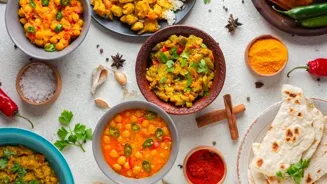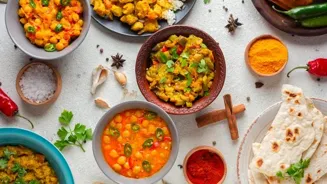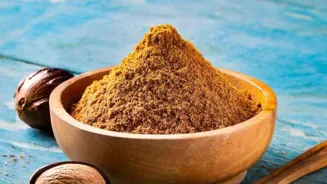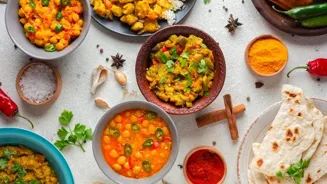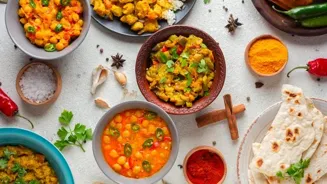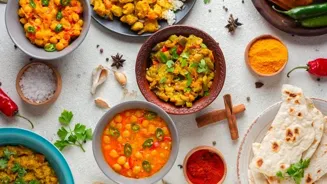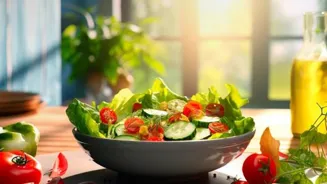Unveiling the Essence of Herbs in Indian Cuisine: A Flavorful Exploration - Discover the secrets behind Indian cooking's rich flavors
For centuries, Indian cooking has been admired around the world for
its depth of flavors and fragrant spices. But often, the unsung heroes behind these delicious dishes are the humble herbs.
From the cool freshness of coriander to the subtle zest of mint, herbs play a vital role in creating the complex and satisfying tastes that define Indian cuisine.
This article will take you on a flavourful journey, exploring the most common herbs used in Indian cooking and how you can easily incorporate them into your daily meals. Get ready to unlock a world of culinary possibilities with these readily available and remarkably versatile ingredients.
They're not just garnishes; they're the secret to taking your Indian cooking from good to unforgettable!
Coriander: versatile herb in Indian cuisine, enhances flavor and adds vibrant color to dishes
One of the most beloved and widely used herbs in Indian cooking is undoubtedly coriander, also known as "dhania" in Hindi. The entire plant, from its roots to its leaves and seeds, is utilized in various ways.
Fresh coriander leaves are often sprinkled generously over dishes as a final touch, adding a burst of fresh, citrusy flavor that balances the richness of curries and dals. The seeds, both whole and ground, are essential components of many spice blends, providing a warm, earthy undertone.
Even the roots are used in some regional cuisines to flavour broths and stews. Coriander is incredibly versatile and pairs well with a wide range of dishes, making it a staple in almost every Indian kitchen.
Not only does it enhance the flavor, but it also adds a vibrant green colour, making the dish visually appealing. Whether you're making a simple vegetable stir-fry or an elaborate biryani, coriander is sure to elevate the dish to new heights.
It's also believed to have digestive properties, making it a healthy and flavourful addition to your meals. Remember to wash and dry coriander thoroughly before using it to remove any dirt or grit.
Mint's versatile uses in cuisine for cooling balance
Next on our list is mint, or "pudina" as it's commonly known. Its cooling and refreshing properties make it the perfect herb to balance the heat of spices, especially during the hot summer months. Mint is used extensively in chutneys, raitas, and refreshing drinks like jal jeera.
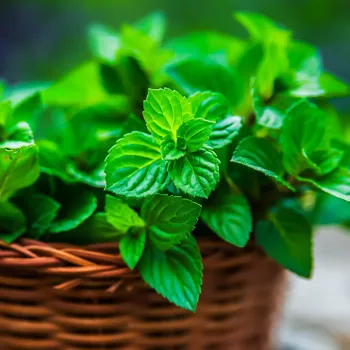
The leaves are often added to biryanis and pulaos, imparting a delicate aroma and a hint of sweetness. In some parts of India, mint is also used to flavour vegetarian kebabs and tikkis.
Its versatility extends beyond savory dishes; mint is also used in desserts like phirni and kheer, adding a refreshing twist to traditional sweets. When using mint, remember that it can be quite potent, so start with a small amount and add more to taste.
Crushing the leaves slightly before adding them to a dish will help release their aromatic oils, enhancing their flavour. You can easily grow mint in a pot at home, ensuring a fresh supply whenever you need it.
The simple act of adding a few mint leaves to your water can instantly make it more refreshing and flavourful.
Curry leaves elevate South Indian dishes with unique flavor
Curry leaves, or "kadi patta," are an indispensable part of South Indian cuisine. Despite their name, they are not related to curry powder. These aromatic leaves have a unique, slightly citrusy and nutty flavour that enhances the taste of dals, sambhar, rasam, and vegetable dishes.
The leaves are typically tempered in hot oil along with other spices like mustard seeds and dried red chilies, releasing their fragrance and infusing the oil with their flavour. This flavourful oil is then used to cook the dish, creating a rich and aromatic base.
Curry leaves are best used fresh, as they lose their flavour when dried. You can often find them at Indian grocery stores. They are also believed to have several health benefits, including aiding digestion and controlling blood sugar levels.
The leaves should be fried till their colour changes and the aroma is released. Curry leaves are a must-have ingredient in any South Indian kitchen, and adding them to your dishes will instantly transport you to the vibrant flavors of the region.
Fenugreek leaves enhance Indian dishes with unique flavor
Fenugreek leaves, known as "methi," are another popular herb used in Indian cooking. Both fresh and dried fenugreek leaves are used, each offering a slightly different flavour profile. Fresh methi leaves have a slightly bitter taste, which mellows out when cooked.
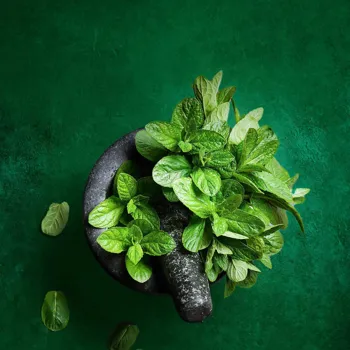
They are commonly used in vegetable dishes like aloo methi (potato and fenugreek leaves) and methi matar malai (fenugreek leaves, peas, and cream). Dried methi leaves, also known as kasuri methi, have a more intense and slightly sweet flavour.
They are often crushed and sprinkled over dishes as a finishing touch, adding a warm and aromatic note. Kasuri methi is also a key ingredient in many Indian curries and lentil dishes. When using fresh methi leaves, it's important to wash them thoroughly and remove any tough stems.
Dried methi leaves should be stored in an airtight container to preserve their flavour and aroma. The distinct flavour of methi adds a unique touch to Indian cuisine, making it a valuable addition to your spice rack.
Dill leaves, rich in antibacterial properties, improve digestion and add flavor to cuisine
Another important herb to consider is Dill, which is locally known as "Suva Bhaji". Suva leaves are commonly used to give additional flavour. It is rich in antibacterial and antioxidant properties. This leaves help improve digestion, reduce inflammation.
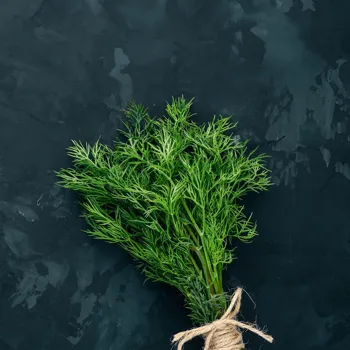
One must prefer Dill leaves to add more flavour to the cuisine. Dill leaves have citrusy and sweet flavour. These leaves are not very common, but are surely healthy and tasty to eat at the same time. These leaves can be used for garnishing the cuisines as well.
Dill leaves are rich in Vitamin A and Vitamin C. These leaves are used in salads.
Experiment with Indian herbs to enhance cooking flavors
In conclusion, herbs are the backbone of Indian cooking, lending their unique flavours and aromas to create the diverse and delicious dishes we all love. Experimenting with these herbs can elevate your cooking and transform your meals into culinary masterpieces.
Start by adding a sprinkle of fresh coriander to your next dal or a few mint leaves to your raita. Use curry leaves to flavour your sambhar or dried fenugreek leaves to add warmth to your curry.
With a little practice, you'll soon discover the magic of herbs and unlock a whole new world of flavour in your Indian cooking. So, embrace the power of herbs and embark on a flavourful journey that will tantalize your taste buds and impress your family and friends.
The possibilities are endless, and the rewards are immense. Happy cooking!
AI Generated Content. Glance/InMobi shall have no liability for the content